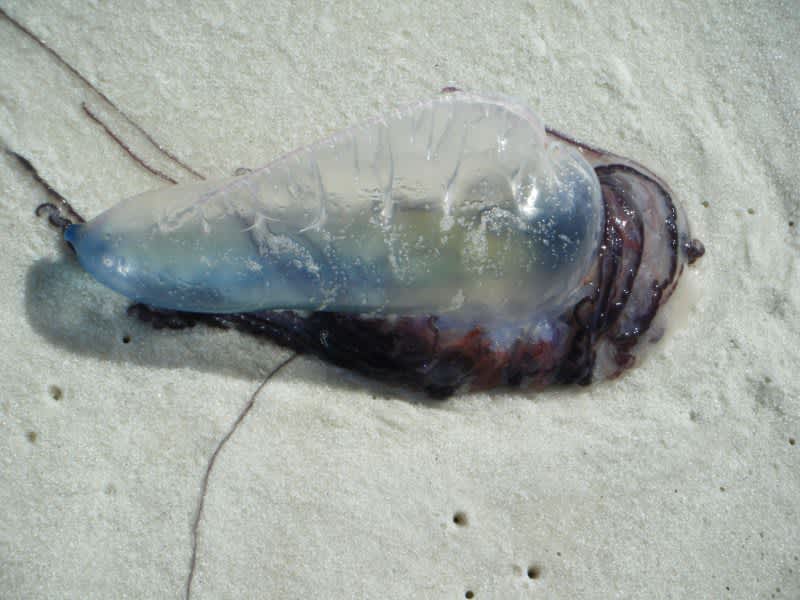Sharing the Ocean with Jellyfish
Dave Maas 06.15.16

Summer is nearly upon us, and it won’t be long until we’re able to fully embrace warm-weather activities. Whether you’ll be doing some kayak fishing or surf casting this summer on the ocean, you are going to have to share the water with some unfriendly fellas, and one to respect is the jellyfish.
When participating in watersports, be it fishing or simply enjoying a day at the beach, it is helpful to be able to recognize potential threats that may exist. Depending on where you’ll be dipping your toes, there could be a warning system in place to alert you to possible dangers present in the water. Some beaches fly flags as a means of informing the public as to what they might encounter on a given day. For the most part these flags indicate water conditions such as the presence of a rip current, but they can also indicate that dangerous marine life is present. If you’re heading into the water and see a purple flag flying, take heed as that is your warning to be on the lookout for jellyfish.
The reason jellyfish are so problematic is because of their sting. Contained within their tentacles are stinging cells called nematocysts. These resemble harpoons, and their intended purpose is to paralyze prey prior to consumption. Despite humans not being jellyfish prey, sometimes we find ourselves accidentally in the line of fire. Speaking of fire, when a jellyfish is disturbed, the nematocysts shoot into the source of said disruption, injecting venom on par with the speed of a moving bullet. This makes it unlikely you can dodge a sting from a jellyfish you do see and impossible when it comes to one you don’t.
Knowing what to expect in terms of jellyfish can be a bit of a mixed bag. Some are so small that they can slip past you completely undetected. Others have a bell practically as large as a Volkswagen Beetle, plus lengthy tentacles. Although your first thought may be that the bigger the jellyfish, the worse the sting, that is not necessarily true. The smallest jellyfish in the world is Irukandji jellyfish. It is about a cubic centimeter in size yet it’s sting is estimated to be 100 times worse than a bite from a cobra. On the other hand, the moon jellyfish is about the size of a dinner plate and their sting does not usually cause harm to people.
First Aid Tips
Because there is so much variation amongst jellyfish species as well as where they are found, being prepared to treat any stings that do occur is useful to swimmers and anglers alike. Mild stings can be treated by first rinsing the affected area with seawater; using freshwater could cause the stinging to become worse. For embedded stingers, use something with a straight edge, such as your driver’s license, to scrape them free. Although you may have heard that urine or a meat tenderizer are useful in treating stings, these are old wives’ tales that have not been proven. Instead, rinse with vinegar or apply baking soda to make a paste in order to neutralize the sting. Afterwards a hot shower is suggested, but avoid rubbing to towel dry as that can cause further irritation, so opt for a pat down instead. Follow up with some calamine lotion or lidocaine and an over-the-counter pain reliever and in most cases you will be good as new.
Severe stings, on the other hand, could require medication attention. Knowing the difference will in large part depend on how you feel after being stung, but it helps to be aware of the type of jellyfish that stung you. Some of the jellyfish most well-known for having a nasty sting include the Sea Nettle, Lion’s Mane Jellyfish, Portuguese Man o’ War, Box Jellyfish, and the aforementioned Irukandji Jellyfish. Stings can result in pain for days or weeks, fever, shock, cramps, headache, vomiting, tachycardia, and even cardiovascular arrest. Therefore, depending on which of these sting you, you may find yourself living through one of your life’s most harrowing experiences, provided you survive the contact at all.
Warm water and plentiful sunlight seems to be what brings jellyfish out in droves, just as it does with humans. Spring and summer are peak times for jellyfish blooms because this is when reproduction occurs due to iodine and oxygen levels in the water being favorable for the growth of new life as are ocean currents. Although a bloom can put a damper on our recreational activities, it is part of the jellyfish cycle of life and this too shall pass.
Despite the inconvenience that jellyfish sometimes pose, they are an important part of the ecosystem. They provide shelter to many juvenile fish and crabs, giving them a place to hide from predation while growing and maturing. Many large fish and sea turtles feed on jellyfish and some people do as well. In fact, cannonball jellyfish are harvested commercially and exported to Asia where they are treated with salt and alum then dried prior to consumption.
While it may hold true that you shouldn’t knock it until you’ve tried it, jellyfish simply may not be a dish for everyone. What you can count on, however, is that after hundreds of millions of years floating through the oceans, jellyfish aren’t going anywhere anytime soon. Keep your eyes peeled for purple flags this summer along with the stinging creatures that could cross your path while having fun in the sun.

